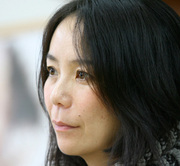
04 The Miracle of Living in the Culture
Naomi Kawase
Film Director
In 2009, I was invited to participate as an international juror in a film festival held in Adelaide, Australia. Adelaide, a city well-known for culture and the arts, hosts the Barossa Music Festival, Adelaide Festival of Arts, Adelaide Film Festival and Adelaide Fringe, as well as Australia's largest world music festival. Many artists and performers from around the globe visit the city during the festivals. The film festival I attended took place in March, coinciding with the Adelaide Festival of Arts. There was a huge parade on an avenue close to where I was staying, and students from the University of Adelaide who dressed up in various costumes strolled the streets, bringing even more festive mood into the city. Small tents set up in a nearby park served as makeshift theatres, which you might see at a traveling funfair. Performers jostled for space wherever crowds gathered, and the entire city became like a wonderland, where everyone from adults to children could enjoy. My four-year-old son, who came with me to Adelaide, was thrilled by them all, and he got even more excited to see some small amusement rides.
When it comes to think of my hometown, Nara, it also has many locations where performers could put on a show. We could have a row of tent theaters in one corner of Nara Park, and offer the opportunities to encounter works of various artists. Wouldn't it be nice if someday both grown-ups and kids could stroll happily around Nara enjoying art, just as they do in Adelaide?
On holidays, some of the streets in Adelaide turn into traffic-free zones where markets are held. There are stalls selling handmade goods, and people giving massage treatments. Painters and fortune-tellers are also on hand; just exploring the markets offers you a very exciting day.
As for the judging, the panel was headed by a curator from the Museum of Modern Art, New York, and everything went well without a hitch. It was very stimulating to have a Nobel laureate author from South Africa among the seven jurors. We had all come from distant countries to gather together in Adelaide, and watched the same movies and then discussed about them. It was a very rewarding period of time. On the last day of our stay, we were given a tour, visiting a winery and having dinner at the adjoining restaurant.
Adelaide and its film festival taught me many things: for one, I learned that the city had had to build up a culture of its own only with its short history that just started after it became a British colony. So policies were put in place basically to construct a culture from scratch. When I heard about these people who had felt the importance of creating a new culture, even at enormous expense, I realized and thanked for a miracle to have been born and raised in Nara, and to be living in a culture that dates back over a thousand years. Of course it is always difficult to start something new in a city with such long history and established culture, and there are big hurdles in the way, but I want to go on playing my part diligently in society, while keeping a sense of pride in my heritage.
 Naomi Kawase
Naomi Kawase
Kawase continues to work out of her hometown Nara. She was awarded the Camera d'Or at the Cannes International Film Festival in 1997 for her film Suzaku (1996) as the youngest winner in its history. Her The Mourning Forest was awarded the Grand Prix at the Cannes International Film Festival in 2007. She has directed many documentary films including Genpin. She lobbied for and is now executive director of the Nara International Film Festival (http://www.nara-iff.jp/en/), which will mark its second year from September 14 to 17, 2012. Nippon Archives series, for which she filmed her beloved Nara and many other sights of Japan, is currently broadcast online. (http://nara.utsukushiki-nippon.jp/)
Official website:http://www.kawasenaomi.com/
Official twitter: http://twitter.com/kawasenaomi
Back Issues
- 2022.7.27 Beyond Disasters - T…
- 2022.6.20 Beyond Disasters - T…
- 2021.6. 7 Contributed Article …
- 2021.4.28 Crossing Borders, En…
- 2021.4.27 Contributed Article …
- 2021.4.20 Contributed Article …
- 2021.3.29 Contributed Article …
- 2020.12.22 Interview with the R…
- 2020.12.21 Interview with the R…
- 2020.11.13 Interview with the R…


